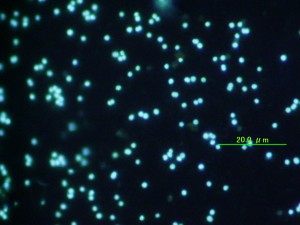Research Highlights
When did Nitrogen Fixation for Supporting Major Life Process begin? ~Discovery of Potential Existence of Nitrogen Fixi...
JAMSETC

Figure 1
A joint research team led by Dr. Manabu Nishizawa, Laboratory of Ocean-Earth Life Evolution Research, Japan Agency for Marine-Earth Science and Technology (JAMSTEC: Asahiko Taira, President), Tokyo University of Agriculture and Technology, and Tokyo Institute of Technology has been pursing research on the origin of nitrogen fixation(*1), aiming to reveal the early expansion of microibal populations and habitats. Nitrogen fixation is considered to be an important factor for biological production(*2) in the oceans because it provides nitrogen compounds for the synthesis of essential molecules such as proteins and nucleic acids (DNA and RNA).
Recently, the team's experiments successfully determined physiological and isotopic characteristics of nitrogen fixation by methanogenic archaea (figure 1) commonly found in deep-sea hydrothermal environments.
The new information obtained from the experiments allows more robust interpretation of geological records of early earth. Consequently, the authors have concluded that it is highly likely that microbial communities supported by nitrogen fixation in hyperthermophilic(*3) methanogens already existed in deep-sea hydrothermal environments 3.5 billion years ago.
These results also suggest the possibility that genes for nitrogen fixation were transferred horizontally from hyperthermophilic methanogen to proto-photosynthetic bacteria in the deep-sea hydrothermal environments on the early Earth, allowing rapid expansion of the microbial ecosystems on the sea surface immediately after the onset of photosynthesis.
These research results have been published in the online Geochimica et Cosmochimica Acta (GCA) on May 16 (Japan time), published by Elsevier Science Ltd, and is sponsored by the Geochemical Society and the Meteoritical Society.
Title: Physiological and isotopic characteristics of nitrogen fixation by hyperthermophilic methanogens: Key insights into nitrogen anabolism of the microbial communities in Archean hydrothermal systems.
Authors: Manabu Nishizawa1, Junichi Miyazaki1,2, Akiko Makabe3,Keisuke Kiba3, Ken Takai1, 2,4
1. Laboratory of Ocean-Earth Life Evolution Research, JAMSTEC
2. Department of Subsurface Geobiological Analysis and Research, JAMSTEC
3. United Graduate School of Agricultural Science, Tokyo University of Agriculture and Technology
4. Earth-Life Science Institute, Tokyo Institute of Technology
*1) Nitrogen fixation
Nitrogen fixation is a process by which nitrogen is converted into ammonium.
In nature, it is carried out by certain microorganisms containing specific enzyme
nitrogenase. Nitrogen is a major element of essential biomolecules such as proteins and nucleic acids (DNA and RNA). Nitrogen is thus essential for all forms of life but usually has to be converted into compounds such as ammonium to be used as a raw material of proteins and nucleic acids.
*2) Biological production
Biological production represents the total amount of living material (biomass) that was produced in a certain space during a defined period of time.
*3) Hyperthermophilic
Biological feature living and thriving in an extremely hot environments above 70 °C.
Click here for JAMSTEC's homepage.
Contact
Japan Agency for Marine-Earth Science and Technology (JAMSTEC)
(For study)
Dr. Manabu Nishizawa, Laboratory of Ocean-Earth Life Evolution Research
Email: m_nishizawa@jamstec.go.jp
(For press release)
Kazushige Kikuchi, Director, Press Division, Public Relations Department
Email: press@jamstec.go.jp












